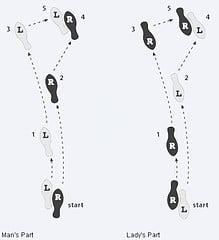In Scent of a Woman, Al Pacino plays retired U.S. Army officer Lieutenant Colonel Frank Slade, a cantankerous blind middle-aged Army veteran. For me one of the most memorable moments was his Tango. Al Pacino makes you believe that he is blind and dancing flawlessly. He makes the dance look effortless and that comes from practice and discipline, a fitting combination for a retired Army officer.
The Tango, like any ballroom dance, has a number of basic steps. Master those and you can dance. However it’s the finesse that sets dancers apart.  And Al Pacino certainly has an abundance of finesse.
And Al Pacino certainly has an abundance of finesse.
Mastering the basics and adding finesse is also a recipe for being flawless in almost any activity, including running a business. Think of each business activity as a different ballroom dance. Each has its own steps. Master the steps and you can dance, market, sell, build, distribute and so on. Unfortunately not everyone in business knows the right steps. That’s where mistakes happen and that’s where workflow comes in.
Think of workflow as your dance instructor. Every time you step on the dance floor, or do your work, your dance instructor is counting off the moves, 1, 2, 3 and 4, - 1, 2, 3, and 4, - 1, 2, 3, and 4. Workflow does the same thing. It gives you the steps you need to complete you dance one step at a time. This allows inexperienced people to dance productively and makes sure that experienced dancers don’t stumble. Consistency is the key to dancing and is also the key to getting things done efficiently in the work place.
Let’s look at a couple of examples. In contract creation and approval every organization has rules that must be followed in order for a contract to be created, approved and signed. These rules are the dance steps for contracts. Some organizations have contract creation requests to their legal department; others might have boilerplate contracts with fill in the blank fields, while other may send contract requirements to the other party. No matter how your organization does things, if you deviate from the norm, your contract will likely run into snags. Codifying your rules into procedures helps eliminate deviations. Automating your procedures helps eliminate errors and omissions.
For now let’s pick one route for a contract. This will probably not be the way that you do it. It doesn’t matter, this is conceptually how you turn your rules into procedures and then into automation.
Imagine that a contract requires that a manager submit a contract request to the legal department. The contract request has a number of items that are required for a contract to be created. These items could be terms, dates, amounts, legal names, and so on. These are all easy to capture on a form.
However the contract request may also require a supervisor’s signature. If the contract is for an amount over a certain limit, it might require approval from a higher level. This is where workflow automation comes in. Once you fill out the contract form, based on rules in the system it will route the contract request to the correct authority for approval. Think about the time saved by automating the contract request approval process. Once the contract has gotten the proper authorization it automatically gets routed to the legal department.
Now that the legal department has the contract they know that the request has been both reviewed and approved cutting down on the amount of time that a contract would need for review. When they complete the draft of the contract it can automatically be routed back to requestor for review, or to the supervisor, or to whoever should receive it next.
This is where the finesse comes in. This is how we dance like Al Pacino at work. By codifying your rules, and creating workflow visually, you can go beyond the basic steps. Map out the basic steps, and then look to see where you can add nuances or finesse. That’s how you take workflow from basic to flawless.
The contract process example can continue all the way through negotiation with the other party to contract revisions, contract approval, and even to electronic signature. Each step in the process has variables that can be codified, taken into account and then diagramed with a visual workflow tool.
Before we get too far into contract automation, let’s be clear about this. This works for hiring, terminations, marketing events, website creation, product creation, accounting, distribution and so on. This is not just about contracts. Everything you do in your organization has steps which can be codified and automated.
Now for the final twirl, big dip and applause, here’s where the power of  DocuVantage OnDemand comes into play. DocuVantage enables you to visually build your workflow rules and then publish/automate them with the click of a mouse. Once published your staff will have DocuVantage as the dance instructor that not only counts out the steps for them, but also ensures finesse!
DocuVantage OnDemand comes into play. DocuVantage enables you to visually build your workflow rules and then publish/automate them with the click of a mouse. Once published your staff will have DocuVantage as the dance instructor that not only counts out the steps for them, but also ensures finesse!
Want to see finesse in action? Sign up for a demo and start dancing like Al Pacino!
